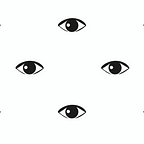Broken Windows theory as it’s practiced today grew out of a 1982 study about public maintenance. Researchers found that keeping up with small repairs can prevent vandalism.
“Social psychologists and police officers tend to agree that if a window in a building is broken and is left unrepaired, all the rest of the windows will soon be broken. This is as true in nice neighborhoods as in rundown ones. Window-breaking does not necessarily occur on a large scale because some areas are inhabited by determined window-breakers whereas others are populated by window-lovers; rather, one un-repaired broken window is a signal that no one cares, and so breaking more windows costs nothing. (It has always been fun.)”
In 1996, some enterprising criminologists imagined the real windows in the study to be symbolic windows that represent whether an act has taken place.
They looked right past the glass and the status of its repair. When the study talked about “vandalism”, they understood it as a signifier of a broken legal statute, not an item being left in pieces. They saw the window as a placeholder that could represent any petty crime.
Once the window has been made into a metaphor, you can see how this study about maintenance came to be used primarily, or most famously, to justify the MTA spending millions on turnstile enforcement and churro prevention.
The theory is that if people see statute violations being cracked down on, they’ll refrain from breaking other statutes because they see that the area is supervised. So they arrest street performers to prevent assaults.
When the window is no longer a window, a repair no longer has to be a repair. And we see, at present, that the windows on the subway look like shit. You can see some windows looking like shit right there, next to these police:
You end up with an area that doesn’t look cared for. But more than that, you end up with arrests and police contacts being used as a proxy for creating a sense of supervision. The logic is that an arrest is a sort of anti-crime — an act by which civil order is increased. But what do people really see when they witness an arrest?
What you see, especially when you involve undercovers, is a lot of unattended fights.
Police interactions, whether you consider any given one justified or not, fundamentally are assaults that bystanders can’t intervene in.
We can define them socially as the opposite of crime, or even personally believe it, but we can’t explain that to our cortisol. Crime is a legal construction, not a visual one. When we see arrests, we see fights that nobody is stopping. That’s one reason, beyond headlines, that perceptions of crime always go up even when crime goes down.
Cracking down on “lifestyle offenses” doesn’t make people feel safer. It doesn’t reduce crime either. Broken Windows theory itself explains why it never will: because each arrest is an altercation that people are forced to watch play out in front of a crowd of bystanders.
Maybe letting performers play music in peace would make people feel safer. Maybe letting people jump turnstiles would cost less and reduce crime. These are what the Broken Windows study suggests would work better than designating a space with some licensed combatants.
